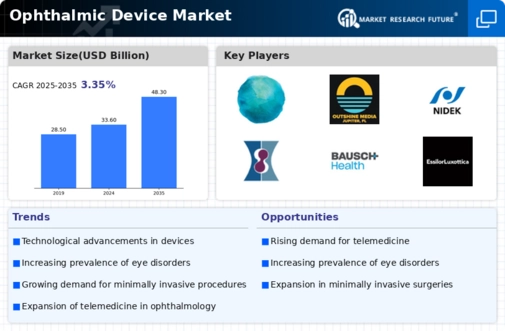Aging Population
The aging population is a critical driver of the Global Ophthalmic Device Market Industry. As life expectancy increases, the number of individuals susceptible to age-related eye conditions rises correspondingly. This demographic shift necessitates a greater demand for ophthalmic devices that cater to the needs of older adults, such as cataract surgery equipment and vision correction solutions. The market's projected growth to 33.6 USD Billion by 2024 reflects this demographic trend. The implications of an aging population on eye health underscore the importance of developing and providing effective ophthalmic solutions.
Market Growth Projections
The Global Ophthalmic Device Market Industry is poised for substantial growth, with projections indicating a market size of 33.6 USD Billion in 2024 and an anticipated increase to 48.3 USD Billion by 2035. This growth trajectory suggests a compound annual growth rate of 3.35% from 2025 to 2035. Such figures highlight the increasing demand for innovative ophthalmic devices driven by factors such as technological advancements, rising healthcare expenditure, and an aging population. The market's expansion reflects a broader commitment to improving eye health globally.
Growing Awareness of Eye Health
There is a marked increase in awareness regarding eye health, significantly influencing the Global Ophthalmic Device Market Industry. Public health campaigns and educational initiatives are encouraging individuals to seek regular eye examinations and adopt preventive measures against vision impairment. This heightened awareness is likely to drive demand for various ophthalmic devices, including diagnostic tools and corrective lenses. As more individuals prioritize eye health, the market is expected to expand, aligning with the projected growth to 48.3 USD Billion by 2035. This trend suggests a proactive approach to managing ocular health on a global scale.
Increasing Healthcare Expenditure
The Global Ophthalmic Device Market Industry benefits from rising healthcare expenditure across various regions. Governments and private sectors are investing more in healthcare infrastructure, which includes the procurement of advanced ophthalmic devices. This trend is particularly evident in emerging economies where improved access to healthcare services is prioritized. As a result, the demand for sophisticated diagnostic and treatment equipment is likely to increase. The anticipated compound annual growth rate of 3.35% from 2025 to 2035 reflects this growing investment, indicating a robust market environment for ophthalmic devices.
Rising Prevalence of Eye Disorders
The Global Ophthalmic Device Market Industry experiences a notable surge due to the increasing prevalence of eye disorders such as cataracts, glaucoma, and age-related macular degeneration. As populations age, the incidence of these conditions rises, necessitating advanced diagnostic and therapeutic devices. For instance, the World Health Organization indicates that by 2024, the market is projected to reach 33.6 USD Billion, driven by the demand for innovative surgical instruments and diagnostic tools. This trend underscores the need for effective management of eye health, thereby propelling the growth of the ophthalmic device sector.
Technological Advancements in Ophthalmic Devices
Technological innovation plays a pivotal role in shaping the Global Ophthalmic Device Market Industry. The introduction of cutting-edge technologies such as minimally invasive surgical techniques, advanced imaging systems, and telemedicine solutions enhances patient outcomes and operational efficiency. For example, the integration of artificial intelligence in diagnostic devices allows for more accurate assessments of ocular conditions. As these technologies evolve, they are expected to contribute significantly to the market's expansion, with projections indicating a growth to 48.3 USD Billion by 2035. This continuous evolution suggests a promising future for ophthalmic devices.



















Leave a Comment